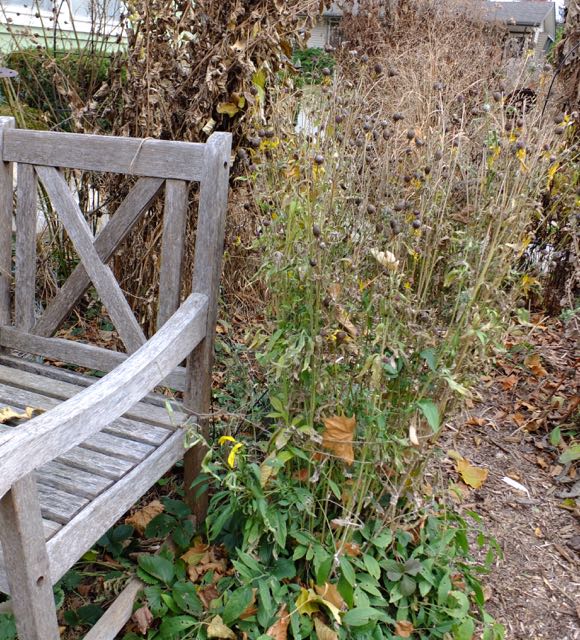We are enjoying a mild fall, even though we've had a number of nights that have dipped down to the 20s. I have mostly wider views for this month's Wildflower Wednesday, hosted by Gail, of Clay and Limestone.
We'll start out with the curb beds. I've mentioned that I do the clean up in the spring, so that birds can have the seeds to eat, and whatever native bees and such who live in the stems can live safely over the winter.
I love the puffy seed heads of the various kinds of liatris. I'm thinking this is aspera.
The spikes of puff on the left are another kind of liatris, I think, a cultivar. I think the dark colored seed heads are black eyed susans.
I guess I really do like liatris seed heads! Here's another clump, with New England asters on the right.
The plant on the left is a coneflower of some kind. The plant in the front is New England aster.
The Mexican hat plants are still green and have some color in their blooms.
This is across from where a sidewalk would be from the west curb area. The wild senna seed heads are pretty cool looking. I'm also seeing more liatris, stiff goldenrod, riddles goldenrod and some grasses in this photo.
The false baptisia on the south side of the fence still has seed pods that look good.
Heading into the area where the tree used to be, we see meadow rue and cup plant.
This was the last clump of New England asters to bloom, and I see it still has one bloom on it.
I found a photo of wild quinine that I liked better than this one, but decided to include both, because if I delete this, I'll have a wider gap that I have to edit the post to fix. The gold in the back is Amsonia illustris.
The gray-headed coneflowers still have a bit of color.
These are sweet black eyed susans.
I just transplanted this clump of ironweed from another part of the yard this spring. It did very well.
Here is the other clump of wild quinine. I have it in several spots in the yard. It has the longest bloom time of all of the flowers, and I see pollinators on it all of its bloom time. It looks nice afterward as well!
I am still enjoying the Illinois bundleflowers.
Since we started with a view from the street, I thought we'd end with a view from the porch.
I hope all is well with you at the holiday season. There are so many bad things happening in the world that are out of our control. What we do have in our control is how we treat others. I hope we all find ways to show kindness and respect to those we come into contact with. This time of year is also a good time to remember to forgive those in your life who have hurt or offended you.
We'll start out with the curb beds. I've mentioned that I do the clean up in the spring, so that birds can have the seeds to eat, and whatever native bees and such who live in the stems can live safely over the winter.
I love the puffy seed heads of the various kinds of liatris. I'm thinking this is aspera.
The spikes of puff on the left are another kind of liatris, I think, a cultivar. I think the dark colored seed heads are black eyed susans.
I guess I really do like liatris seed heads! Here's another clump, with New England asters on the right.
The plant on the left is a coneflower of some kind. The plant in the front is New England aster.
The Mexican hat plants are still green and have some color in their blooms.
This is across from where a sidewalk would be from the west curb area. The wild senna seed heads are pretty cool looking. I'm also seeing more liatris, stiff goldenrod, riddles goldenrod and some grasses in this photo.
The false baptisia on the south side of the fence still has seed pods that look good.
Heading into the area where the tree used to be, we see meadow rue and cup plant.
This was the last clump of New England asters to bloom, and I see it still has one bloom on it.
I found a photo of wild quinine that I liked better than this one, but decided to include both, because if I delete this, I'll have a wider gap that I have to edit the post to fix. The gold in the back is Amsonia illustris.
The gray-headed coneflowers still have a bit of color.
These are sweet black eyed susans.
I just transplanted this clump of ironweed from another part of the yard this spring. It did very well.
Here is the other clump of wild quinine. I have it in several spots in the yard. It has the longest bloom time of all of the flowers, and I see pollinators on it all of its bloom time. It looks nice afterward as well!
I am still enjoying the Illinois bundleflowers.
Since we started with a view from the street, I thought we'd end with a view from the porch.
I hope all is well with you at the holiday season. There are so many bad things happening in the world that are out of our control. What we do have in our control is how we treat others. I hope we all find ways to show kindness and respect to those we come into contact with. This time of year is also a good time to remember to forgive those in your life who have hurt or offended you.

























































